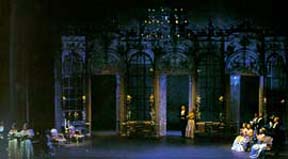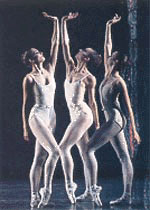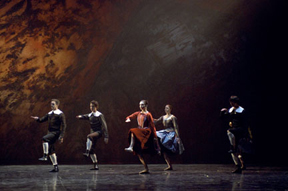 This all-Balanchine, all Brahms (via Schoenberg’s orchestration of Brahms’ “Piano Quartet in G Minor”) evening had more variety, more richness, and more beauty than any comparable two hours I can think of. “Liebeslieder Walzer”, that grandmother of all piano ballets, remains one of the most subtly dramatic works of art ever made. Four very well-off couples from 19th century Vienna waltz with each other for an hour, and by the end the audience feels as if it knows every emotional detail of their lives — at least it does in a well-danced version, which this, by and large, was. READ MORE
This all-Balanchine, all Brahms (via Schoenberg’s orchestration of Brahms’ “Piano Quartet in G Minor”) evening had more variety, more richness, and more beauty than any comparable two hours I can think of. “Liebeslieder Walzer”, that grandmother of all piano ballets, remains one of the most subtly dramatic works of art ever made. Four very well-off couples from 19th century Vienna waltz with each other for an hour, and by the end the audience feels as if it knows every emotional detail of their lives — at least it does in a well-danced version, which this, by and large, was. READ MORE
Lush clarity
by Susan Reiter
 It is quite amazing to experience the lean, rarefied clarity of “Monumentum Pro Gesualdo,” having viewed the exquisite, leisurely unfurling of intensely romantic limpidity that is “Liebeslieder Walzer” the previous evening, and to grasp that both works were created simultaneously by George Balanchine, premiering six days apart in 1960. (Not to mention that he unveiled a buoyant bauble of delightful verve called “Donizetti Variations” on the same evening as “Monumentum.”) One is always aware of the scope and stature of the Balanchine repertory, but to have three such enduring — and completely different — works all in active repertory at the same time certainly reinforces that reality. READ MORE
It is quite amazing to experience the lean, rarefied clarity of “Monumentum Pro Gesualdo,” having viewed the exquisite, leisurely unfurling of intensely romantic limpidity that is “Liebeslieder Walzer” the previous evening, and to grasp that both works were created simultaneously by George Balanchine, premiering six days apart in 1960. (Not to mention that he unveiled a buoyant bauble of delightful verve called “Donizetti Variations” on the same evening as “Monumentum.”) One is always aware of the scope and stature of the Balanchine repertory, but to have three such enduring — and completely different — works all in active repertory at the same time certainly reinforces that reality. READ MORE
The end of the road
by Eva Kistrup
 Danish Ballet Master Frank Andersen likes the concept of themed seasons. Last season was a Bournonville year. This season the theme is new choreography. Even though I agree with him on the value of having the dancers participate in the choreographic process, I wish, based on this season's repertoire, that the choreographers were chosen not so much by the themic criteria as on quality. Save for Jorma Uotinen's "Earth" and Tim Rushton's "Requiem," the bulk of new choreography for the company has been dull, unambitious and of little lasting value. We have seen ballets inspired by Danish architect Arne Jacobsen, Heavy Metal, and, in this last programme, Chinese choreographer Yuan Yuan Wang could present no better subject than the "colour of love". On stage the always good and expressive Tina Højlund danced the subject of love in three ages supported by Jean Lucien Massot and a sofa, which did almost as many lifts as Massot. Around the couple a group of eight dancers moved without much reason or meaning. This banal work had the dept of an issue of "Cosmopolitan". READ MORE
Danish Ballet Master Frank Andersen likes the concept of themed seasons. Last season was a Bournonville year. This season the theme is new choreography. Even though I agree with him on the value of having the dancers participate in the choreographic process, I wish, based on this season's repertoire, that the choreographers were chosen not so much by the themic criteria as on quality. Save for Jorma Uotinen's "Earth" and Tim Rushton's "Requiem," the bulk of new choreography for the company has been dull, unambitious and of little lasting value. We have seen ballets inspired by Danish architect Arne Jacobsen, Heavy Metal, and, in this last programme, Chinese choreographer Yuan Yuan Wang could present no better subject than the "colour of love". On stage the always good and expressive Tina Højlund danced the subject of love in three ages supported by Jean Lucien Massot and a sofa, which did almost as many lifts as Massot. Around the couple a group of eight dancers moved without much reason or meaning. This banal work had the dept of an issue of "Cosmopolitan". READ MORE
 Christopher Williams was blessed with the ideal venue for his two-part program of dances dealing, in turn, with the lives of saints and the love of sinners. In the lofty confines of St. Mark’s Church-in-the-Bowery, we saw that pain comes not from God, but from man. For despite the choreographer’s unerring evocation of the underlying erotics of pain and intrusion that informs even the most chaste hagiography, this was a program more sacred than profane. READ MORE
Christopher Williams was blessed with the ideal venue for his two-part program of dances dealing, in turn, with the lives of saints and the love of sinners. In the lofty confines of St. Mark’s Church-in-the-Bowery, we saw that pain comes not from God, but from man. For despite the choreographer’s unerring evocation of the underlying erotics of pain and intrusion that informs even the most chaste hagiography, this was a program more sacred than profane. READ MORE
 This all-Balanchine, all Brahms (via Schoenberg’s orchestration of Brahms’ “Piano Quartet in G Minor”) evening had more variety, more richness, and more beauty than any comparable two hours I can think of. “Liebeslieder Walzer”, that grandmother of all piano ballets, remains one of the most subtly dramatic works of art ever made. Four very well-off couples from 19th century Vienna waltz with each other for an hour, and by the end the audience feels as if it knows every emotional detail of their lives — at least it does in a well-danced version, which this, by and large, was. READ MORE
This all-Balanchine, all Brahms (via Schoenberg’s orchestration of Brahms’ “Piano Quartet in G Minor”) evening had more variety, more richness, and more beauty than any comparable two hours I can think of. “Liebeslieder Walzer”, that grandmother of all piano ballets, remains one of the most subtly dramatic works of art ever made. Four very well-off couples from 19th century Vienna waltz with each other for an hour, and by the end the audience feels as if it knows every emotional detail of their lives — at least it does in a well-danced version, which this, by and large, was. READ MORE  It is quite amazing to experience the lean, rarefied clarity of “Monumentum Pro Gesualdo,” having viewed the exquisite, leisurely unfurling of intensely romantic limpidity that is “Liebeslieder Walzer” the previous evening, and to grasp that both works were created simultaneously by George Balanchine, premiering six days apart in 1960. (Not to mention that he unveiled a buoyant bauble of delightful verve called “Donizetti Variations” on the same evening as “Monumentum.”) One is always aware of the scope and stature of the Balanchine repertory, but to have three such enduring — and completely different — works all in active repertory at the same time certainly reinforces that reality. READ MORE
It is quite amazing to experience the lean, rarefied clarity of “Monumentum Pro Gesualdo,” having viewed the exquisite, leisurely unfurling of intensely romantic limpidity that is “Liebeslieder Walzer” the previous evening, and to grasp that both works were created simultaneously by George Balanchine, premiering six days apart in 1960. (Not to mention that he unveiled a buoyant bauble of delightful verve called “Donizetti Variations” on the same evening as “Monumentum.”) One is always aware of the scope and stature of the Balanchine repertory, but to have three such enduring — and completely different — works all in active repertory at the same time certainly reinforces that reality. READ MORE  Danish Ballet Master Frank Andersen likes the concept of themed seasons. Last season was a Bournonville year. This season the theme is new choreography. Even though I agree with him on the value of having the dancers participate in the choreographic process, I wish, based on this season's repertoire, that the choreographers were chosen not so much by the themic criteria as on quality. Save for Jorma Uotinen's "Earth" and Tim Rushton's "Requiem," the bulk of new choreography for the company has been dull, unambitious and of little lasting value. We have seen ballets inspired by Danish architect Arne Jacobsen, Heavy Metal, and, in this last programme, Chinese choreographer Yuan Yuan Wang could present no better subject than the "colour of love". On stage the always good and expressive Tina Højlund danced the subject of love in three ages supported by Jean Lucien Massot and a sofa, which did almost as many lifts as Massot. Around the couple a group of eight dancers moved without much reason or meaning. This banal work had the dept of an issue of "Cosmopolitan".
Danish Ballet Master Frank Andersen likes the concept of themed seasons. Last season was a Bournonville year. This season the theme is new choreography. Even though I agree with him on the value of having the dancers participate in the choreographic process, I wish, based on this season's repertoire, that the choreographers were chosen not so much by the themic criteria as on quality. Save for Jorma Uotinen's "Earth" and Tim Rushton's "Requiem," the bulk of new choreography for the company has been dull, unambitious and of little lasting value. We have seen ballets inspired by Danish architect Arne Jacobsen, Heavy Metal, and, in this last programme, Chinese choreographer Yuan Yuan Wang could present no better subject than the "colour of love". On stage the always good and expressive Tina Højlund danced the subject of love in three ages supported by Jean Lucien Massot and a sofa, which did almost as many lifts as Massot. Around the couple a group of eight dancers moved without much reason or meaning. This banal work had the dept of an issue of "Cosmopolitan".  Christopher Williams was blessed with the ideal venue for his two-part program of dances dealing, in turn, with the lives of saints and the love of sinners. In the lofty confines of St. Mark’s Church-in-the-Bowery, we saw that pain comes not from God, but from man. For despite the choreographer’s unerring evocation of the underlying erotics of pain and intrusion that informs even the most chaste hagiography, this was a program more sacred than profane.
Christopher Williams was blessed with the ideal venue for his two-part program of dances dealing, in turn, with the lives of saints and the love of sinners. In the lofty confines of St. Mark’s Church-in-the-Bowery, we saw that pain comes not from God, but from man. For despite the choreographer’s unerring evocation of the underlying erotics of pain and intrusion that informs even the most chaste hagiography, this was a program more sacred than profane.